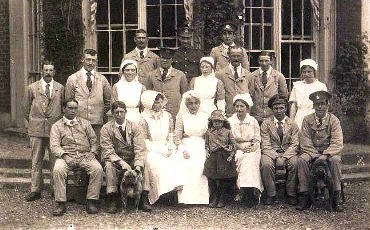|
|
VAD Hospital at Boxmoor From the Watford Observer 1st January, 1916 |
|
|
MODEL HOSPITAL AT BOXMOOR The hospital at Boxmoor is a small one but is quite a model institution, replete with every convenience. The spacious rooms of Boxmoor House, a fine old modernised residence kindly lent for this noble work by Mrs Bouwens, have been adapted to the best possible advantage, and the result is an up-to-date hospital of more than usual attractiveness. There are altogether twenty beds, divided into three wards, two of eight beds each and one of four beds. The two larger wards are delightfully situated, and overlook the charming grounds of the house and the beautiful common beyond. Mrs Bouwens who, in addition to giving up a large part of her beautiful home, makes herself responsible for the heating and lighting of the building, is in charge of the hospital, and takes a keen personal interest in its management; she has a very co-adjutor in Miss Bouwens, of the VAD to whom is deputed much of the power in the housekeeping arrangements and general administration. The medical work is in charge of Sister Blackmore, who has under her a staff of VAD nurses, seven or eight in number, according to the number of patients. The doctors on the visiting list are Dr Hubert, of Berkhamsted, and Dr Lestock Reid, of Watford. Although the hospital was only opened on October 26th, 54 patients have been admitted; all come from the central hospital at Aylesbury (Eastern Command), to which the Boxmoor hospital is a convalescent auxiliary. Most of the patients have been soldiers who have contracted illness while in home training camps, but there have also been two men from Suvla Bay1 and several from France, including cases of "gassing". Mrs Bouwens refers with gratitude to the kindness of neighbours, who kindly lent the beds and bedding with which the wards are so well equipped; neighbours are also very liberal with gifts of fruit and vegetables. In addition to the medical attention which the men receive under such excellent conditions, there is ample provision for recreation purposes. The conservatory is given over to men as a day room, where they can sit over a cosy fire and read papers and periodicals. The big coachhouse has been transformed into a fine recreation room, with hammock and easy chairs, card tables, bagatelle board, and a piano. The men organise whist drives and concerts, and in connection with the latter solicit assistance from the nursing staff, which is readily given and much appreciated. Mrs Seaton on one occasion brought friends to the hospital, who gave a capital concert, and occasionally a thoughtful motorist calls with his car and takes the patients for a ride. It is unnecessary to detail all the other accommodation which the hospital provides, such as the two bath-rooms, dining hall, &c; it is sufficient to say that it is a comfortable little institution, obviously well managed. ... [The patients] only had one complaint to make, and that was that the weather prevents them taking as much advantage as they would like of the facilities which the neighbourhood affords for pleasant country rambles. ... We may add that Mrs Bouwens would like two more VAD trained nurses in January, and will forward all particulars to applicants. 1 Gallipoli. The divisions landing on this beach in August, 1915, were the 10 (Irish), 11th (Northern), and 53rd & 54th (Territorial). |
 |
Postcard of patients at the hospital described above. See also Military Hospitals in World War One |

